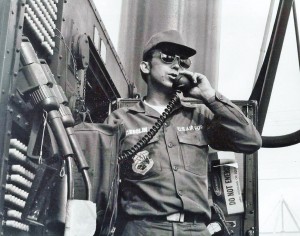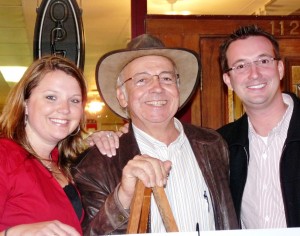Service to Country Followed by Service to Community
By Julie Anderson
Editor
As an only child, he grew up in a small town outside of Cincinnati working on his parents’ 300-acre farm.
As a young man facing the draft, he opted for the U.S. Air Force where he found himself in Weymouth, England, as a communications technician relaying radio signals through England, Spain and Turkey back to the United States.
As an adult who continued serving his country, he was on the ground floor of the transformation of combat communications, when the Air National Guard not only transitioned from gear used in World War II to modern equipment, but also enlarged its mission scope requiring intense training orchestrated by Geeslin at his Guard unit.
Henderson County Commissioner Ken Geeslin’s timeline is characterized by these types of scenarios, all of which point to a pattern typical of many of our U.S. veterans: service to country followed by service to community.
Service Timeline
With the draft nearly upon him, Ken Geeslin, an 18-year-old college student, broke from his studies and enlisted in the U.S. Air Force in 1967. Geeslin completed basic training at Lackland Air Force Base in San Antonio and radio relay technician training at Keesler Air Force Base in Biloxi, Miss., and was then sent on a three-year tour to England, where he maintained a “tropo” site as well as microwave facilities.
“It was a unique facility from the standpoint that it had two 120-foot billboard antennas providing for the longest tropo shot in the world,” Geeslin described. Tropospheric communications is a form of radio transmission that bounces a signal off of the troposphere, or the lowest layer of the Earth’s atmosphere. This communications link in Ringstead, England, tied transmissions to Gorramendi, Spain, and from there throughout Europe as far east as Turkey, back to the United States. When his three years were up, Geeslin extended for two years in England before returning to Andrews Air Force Base in Maryland, where Geeslin oversaw all microwave communications with multiple sites including the Pentagon, which included support for closeout operations in Vietnam.
Faced with a potential assignment to a remote mountaintop in Greece, Geeslin transitioned from active duty in 1974 to the D.C. Air National Guard, where he worked full time for five years; he then continued with weekend duty for another decade.
During this time in the Guard, which included stints in the D.C. and Texas units, Geeslin was on the ground floor of two transitions: 1) replacement of still-used World War II-era equipment and technology, and 2) the retasking of Guard and Reserve units, known as “weekend warriors” because they trained one weekend out of each month. Based on lessons learned during the Vietnam Conflict, the Department of Defense decided the Guard would play a more significant role in operations, Geeslin detailed. For example, from 1974-75, the Air National Guard Units were assigned an actual communication mission.
“We went from an organization made up of individuals who were truly weekend warriors to an organization with a critical mission to support the nation in conflicts that required communication,” Geeslin recalled.
Throughout his time in the Guard, Geeslin also took a leadership role in Joint Chief of Staff Operational Readiness Exercises, where units were tested and evaluated on all aspects of communication. In one such exercise, the site was hit with simulated smoke grenades and chemical warfare, forcing the participants to wear gas masks and chemical suits while keeping communications operational. In another exercise, members of the Guard were required to react when a primary facility was blown up, meaning the rerouting of all communication traffic; participants were evaluated on the quickness of their response and their efforts to minimize impact on their overall mission.
Geeslin retired from the Guard in 1989 as a decorated Master Sergeant and then went on to serve in the U.S. Air Force Reserve from 1989-2003.
While still in the Air National Guard, Geeslin took his engineering and telecommunications experience into the private sector, signing on with MCI Telecommunications in 1980. His leadership responsibilities consisted of budgets, engineering, construction, operations and executive-level program management. In fact, Geeslin became the driving force behind many industry innovative solutions such as the leadership of the Federal Aviation Administration’s (FAA’s) Leased Interfacility National Air Space Communications System, the network that supports all U.S. airspace for civil and military air traffic control. His work on this high-profile project earned Geeslin awards from both the FAA and MCI.
Geeslin led the first large-scale deployment of single-mode fiber optic communications cable between Washington, D.C., and New York. He later led the deployment of high-density polyethylene pipe for outside plant fiber optic installation that became the industry standard, as it hardened the network, reduced cost and sped up the installation process.
His career highlights also include the development of emergency restoration processes for restoring microwave radio towers, followed by the development of fiber optic network disaster recovery initiatives.
After 25 years in the corporate world, Geeslin returned to his small-town roots, moving with his wife, Katherine, to Athens, Henderson County, in 2001. The following year, Geeslin and his wife established a joint venture offering consulting services to failing companies with a turn-key timeline to profitability. In 2005, the Geeslins began representing fortune 500 companies with restoration and relocation of fiber optic outside plant networks.
Geeslin’s 26 years of military, Guard and Reserve service, some of which overlapped with his 25 years in the private sector, all focused on improvements that affected a nation. As he settled into a smaller setting, Geeslin turned his sights to the local community, educating himself by attending Commissioners Court and school district meetings along with other town events.
In 2005, he ran for County Commissioner but was not elected. However, Geeslin continued to attend county meetings and successfully ran for the Commissioner’s seat in 2010. He was recently re-elected to his second term and serves as a full-time Henderson County Commissioner.
Converging Experiences
Serving. Communicating. Training. Leading. Transitioning. Planning. Responding. The skills and worth ethic acquired and refined during Geeslin’s military service and related career in communications have all been put to good use in his role as Henderson County Commissioner. For example, one of the first items of business upon his election concerned the county purchase of a bank building that would be converted into a county annex. The plan necessitated the replacement of phone and Internet service, and Geeslin’s experience was vital when it came to negotiating the contract. Geeslin advised replacing the existing system with a voiceover IP system, “which resulted in charges being cut in half,” he reported.
On the road and bridge side, Geeslin was instrumental in connecting the county with a government surplus program resulting in the purchase of military trucks with very few miles being converted into county dump trucks.
“We’ve been able to upgrade equipment in our precinct utilizing that government program,” Geeslin shared, “buying dozers, welding equipment, and oil in bulk all at a fraction of the retail cost saving thousands of dollars.
“The equipment is reliable, and the taxpayer didn’t have to pay that premium,” he continued.
In his years on Commissioners Court, Geeslin has maintained a focus of “putting procedures in place that streamline county government and, in the long term, save our taxpayers money.”
When it comes to his favorite part of the job, Geeslin cites “making a difference.”
No doubt his timeline of service has made a difference in his family, especially considering one of his daughters followed his footsteps into the U.S. Air Force.
Ken and Katherine Geeslin have four children, sons Matt and John and daughters Jennifer and Malia. They are also proud grandparents of five granddaughters: Sarah Grace, Sidney Elizabeth, Ella Marie, Cora Maree and Meredith Grace. Geeslin’s daughter Jennifer is now a Major with the Massachusetts National Guard.
Finally, Geeslin’s commitment to effective and efficient communication, one of the focal point of his military and private careers, has translated into an obvious steadfastness when it comes to keeping his constituents informed; Geeslin maintains a comprehensive county web page, http://www.henderson-county.com/departments/commissioners-court/commissioner-precinct-4, complete with organizational chart, the latest road reports, community information, voting locations and more.
This type of commitment fits right in with one of the Air Force Core Values that a young Ken Geeslin memorized back in the 1960s when he put on the Air Force uniform: “Excellence In All We Do.”
















